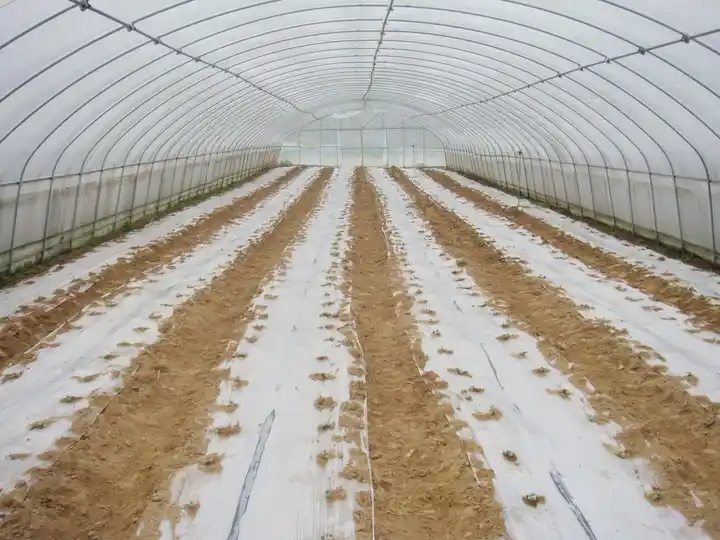China has a diverse range of greenhouse structures that are used for agricultural and horticultural purposes.
Some common types of greenhouses found in China include:
- Plastic Film Greenhouses: Plastic film greenhouses are widely used in China due to their cost-effectiveness and versatility. They are constructed with a metal or bamboo frame covered with a single or double layer of plastic film. Plastic film greenhouses are suitable for a variety of crops and provide protection from adverse weather conditions.
- Glass Greenhouses: Glass greenhouses are commonly used in China, particularly in commercial operations and areas with harsh weather conditions. They offer better light transmission and durability compared to plastic film greenhouses. Glass greenhouses often have a sturdy metal frame and tempered glass panels.
- Polycarbonate Greenhouses: Polycarbonate greenhouses are gaining popularity in China due to their excellent light transmission, durability, and insulation properties. These greenhouses feature a metal frame and polycarbonate panels, which provide good thermal insulation and impact resistance.
- Solar Greenhouses: Solar greenhouses are a unique type of greenhouse widely used in China, especially in northern regions with cold climates. They are designed to harness solar energy for heating purposes, allowing for year-round cultivation even in cold weather. Solar greenhouses are often built with an angled roof and north-facing transparent walls to maximize heat absorption.
- Venlo Greenhouses: Venlo-style greenhouses, characterized by their gable roof and multiple glass panels, are also found in China. These greenhouses offer good light transmission and efficient use of space. Venlo greenhouses are often used for commercial flower and vegetable production.
- Tunnel Greenhouses: Tunnel greenhouses, also known as hoop houses or arch greenhouses, are simple and cost-effective structures commonly used in China. They consist of a series of arched frames covered with plastic film. Tunnel greenhouses are easy to construct and are suitable for small-scale or seasonal crop production.
- Multi-Span Greenhouses: Multi-span greenhouses are large-scale structures that consist of multiple connected greenhouse units. They are commonly used in China for commercial agricultural production. Multi-span greenhouses offer high productivity and efficient use of space, enabling growers to cultivate a wide range of crops.
It’s important to note that China has a vast agricultural industry, and greenhouse types and designs can vary depending on the region, climate, crop type, chinese style greenhouse and specific agricultural practices. Additionally, China is known for its innovations in greenhouse technology, including the adoption of advanced automation, climate control systems, and energy-efficient designs.
Here are some additional details about greenhouse types in China:
- Aquaponic Greenhouses: Aquaponic greenhouses combine aquaculture (fish farming) with hydroponics (soilless plant cultivation). They utilize a recirculating system where fish waste provides nutrients for plants, and the plants’ roots filter and purify the water for the fish. Aquaponic greenhouses are gaining popularity in China due to their efficient use of resources and high productivity.
- Intelligent Greenhouses: China is at the forefront of developing intelligent or smart greenhouse technologies. These greenhouses incorporate advanced automation, robotics, and sensor systems to optimize environmental control, irrigation, and crop management. Intelligent greenhouses in China often feature precise climate control, remote monitoring, and data-driven decision-making for improved productivity and resource efficiency.
- Energy-Saving Greenhouses: Given China’s focus on sustainable agriculture and energy conservation, energy-saving greenhouses have become increasingly prevalent. These greenhouses are designed to minimize energy consumption through various strategies, such as improved insulation, energy-efficient heating and cooling systems, solar energy utilization, and thermal curtains to reduce heat loss.
- Vertical Farming Systems: In urban areas with limited space, vertical farming systems have gained popularity. These systems involve the cultivation of plants in vertically stacked layers or racks, typically indoors or in controlled environments. Vertical farms often utilize LED grow lights, hydroponic or aeroponic systems, and advanced climate control to maximize space utilization and crop yields.
- Combination Structures: Many greenhouse operations in China employ combination structures that combine different greenhouse types to meet specific needs. For example, a greenhouse may have a glass or polycarbonate main structure for long-term cultivation and a plastic film-covered section for seasonal crops. These combination structures allow for flexibility in crop production and adaptability to changing weather conditions.
- Research and Demonstration Greenhouses: China also has numerous research and demonstration greenhouses that serve as testing grounds for new technologies, cultivation techniques, and crop varieties. These greenhouses are often associated with research institutions, universities, and agricultural extension services, contributing to advancements in greenhouse agriculture practices.
- Greenhouse Clusters: In certain regions of China, greenhouse clusters or greenhouse complexes can be found. These are large-scale agricultural production areas where multiple greenhouses are grouped together. These clusters often benefit from shared resources, infrastructure, and knowledge exchange among growers.
- Greenhouse Technology Exports: China has become a major player in the global greenhouse industry, with many Chinese greenhouse manufacturers exporting their products and technologies worldwide. Chinese greenhouse technology, including energy-efficient designs, automation systems, and low-cost structures, has been adopted by growers in various countries.
It’s worth noting that China’s greenhouse industry is dynamic and continuously evolving, with ongoing research, innovation, and adoption of new technologies to improve productivity, resource efficiency, and sustainability in agricultural practices.
